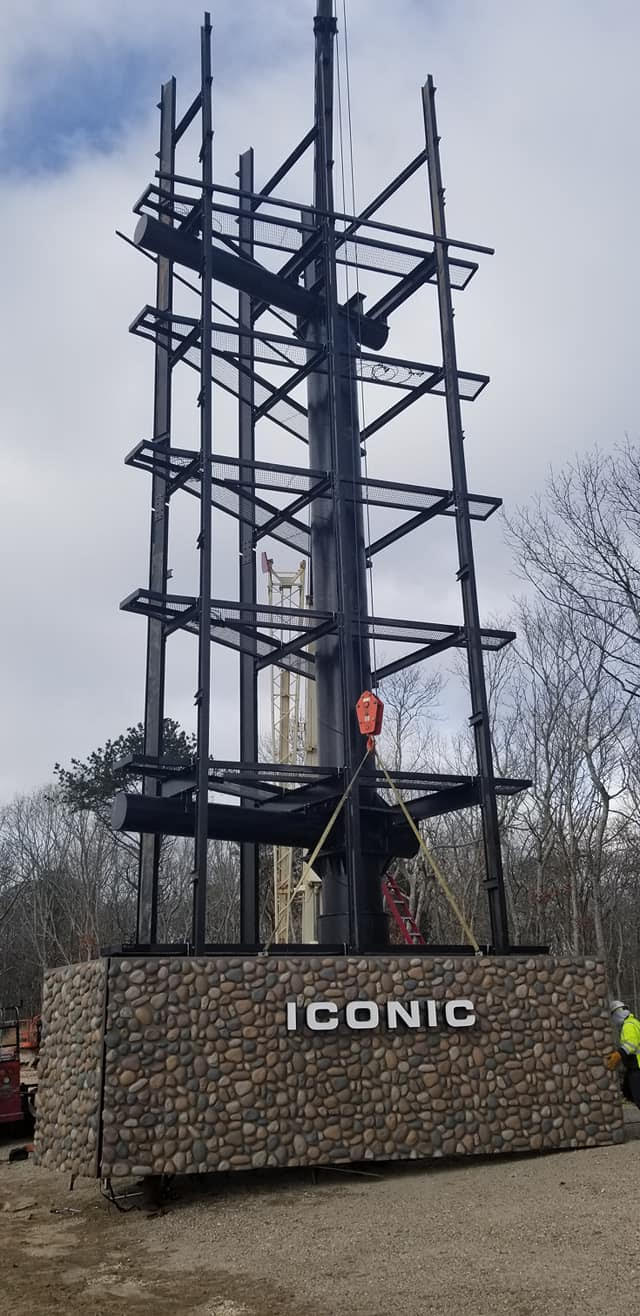NEW YORK — New York State Department of Transportation (NYSDOT) last Friday issued the Shinnecock Indian Nation an order to stop work on a second 61-foot digital billboard along Sunrise Highway on Long Island, despite a state supreme court ruling a year earlier in favor of tribal jurisdiction for the construction of an identical billboard on the opposite side of the highway.

In a letter addressed to all seven Tribal Council members, DOT’s assistant counsel wrote that the department intends to fine the Nation $2,000 a day — $1,000 for each billboard — for working without a permit, beginning Jan. 29. After 30 days of the written request, the letter said, “NYSDOT may remove the sign.”
Shinnecock Tribal Ambassador and former Vice Chairman Lance Gumbs told Native News Online that the nation does not intend to back down, or stop working to install the second sign. “We went through that same thing before when they issued stop work orders,” he said. “The DOT does not have the jurisdiction to stop us from working on tribal lands. It's an attack on the sovereignty of the Shinnecock Nation, and that's not going to happen. We're not going to allow that to happen.”
Nearly two years ago, the Shinnecock began constructing its initial eastbound billboard, visible to oncoming traffic at the gateway to the Hamptons, as a means to generate advertising revenue to fund tribal government and services.
At the time the billboard was erected, the Shinnecock Indian Nation faced strong resistance from the adjacent town of Southampton, which served the tribal nation with a cease-and-desist order. The town said the nation began building the billboard without the proper local permits. As a federally recognized tribe that gained recognition in 2010, the Shinnecock Nation maintained that because it is a sovereign nation, it did not need to apply for local permits.
NYSDOT sought an injunction to have the existing sign removed and prevent the construction of the second billboard sign. In May 2019, the New York State Attorney General’s Office brought a lawsuit against the officers of the Shinnecock Indian Nation, soon after the first sign was operational, but before the second sign could be completed.
Suffolk County Supreme Court Judge Berland ultimately sided with the nation, citing their sovereignty rights and rejecting the merits of the state’s arguments that the sign itself posed a hazard.
Vice Chairman Gumbs on Monday said the two-year legal hold up has cost the tribe an estimated $5 million in lost revenue, not including the cost of litigation. “It is hurting our tribe economically because these funds were already earmarked to go towards our social programs our housing, our senior program, our education program, and our health programs — and so especially during this pandemic, these funds could be really needed,” Gumbs said.
He noted the irony in the fact that the same state government bringing threats of fines and forcible removal of the nation’s billboards was recently a client that paid the tribe to advertise on the existing sign last summer for its Safe Boating Courses.
Additionally, the billboards were used to broadcast Covid-19 preparedness and protocol for free to visitors of Southampton during the height of the pandemic, when many New York residents fled New York City.
NYSDOT did not immediately respond to request for comment. Gumbs said the nation has yet to receive any fines from the state as of Monday evening.
On the highway last Friday, cars driving past the billboards saw the Shinnecock Indian Nation flag flying from the westbound structure in what Gumbs called symbolism of the will and determination of tribal members.
“We will never stand down for our right to use our land for the betterment of our people and future generations,” he said.
More Stories Like This
Native News Weekly (August 25, 2024): D.C. BriefsUS Presidents in Their Own Words Concerning American Indians
Ethics Complaint Alleges Former Navajo Nation Chief of Staff Accepted Gifts From Contractor
Monday Morning (December 14, 2025): Articles You May Have Missed This Past Weekend
Native News Weekly (December 14, 2025): D.C. Briefs
Help us defend tribal sovereignty.
At Native News Online, our mission is rooted in telling the stories that strengthen sovereignty and uplift Indigenous voices — not just at year’s end, but every single day.
Because of your generosity last year, we were able to keep our reporters on the ground in tribal communities, at national gatherings and in the halls of Congress — covering the issues that matter most to Indian Country: sovereignty, culture, education, health and economic opportunity.
That support sustained us through a tough year in 2025. Now, as we look to the year ahead, we need your help right now to ensure warrior journalism remains strong — reporting that defends tribal sovereignty, amplifies Native truth, and holds power accountable.
 The stakes couldn't be higher. Your support keeps Native voices heard, Native stories told and Native sovereignty defended.
The stakes couldn't be higher. Your support keeps Native voices heard, Native stories told and Native sovereignty defended.
Stand with Warrior Journalism today.
Levi Rickert (Potawatomi), Editor & Publisher

